Despite rapidly developing marketing technologies and the growing popularity of social media, email marketing is still alive and well. Any thorough review of the latest email marketing statistics will tell you the same story.
“Bold predictions” may say that “email marketing is dead,” but it’s definitely not. Email is a powerful channel with unmatched reach for marketers that know how to use it. Plus, it’s a channel with unheard-of ROI (more on this later).
Even with fuller inboxes and, on paper, consumers that see more advertising than ever before, it really works when done right.
Let’s skip the chit-chat and dive straight into the latest email marketing statistics we’ve curated here in this blog post!
Email Is a Top 3 Distribution Channel for Both B2C and B2B Marketers
While B2C and B2B marketers may have different goals, email is still one of the most reliable methods to boost content marketing.
87% of B2B marketers use email as a distribution channel.

It comes in second after social media and is more common than using a company blog.
B2C content marketing experts also turn to email to help distribute their content. 79% of B2C marketers rely on email to spread their new articles or blog posts.
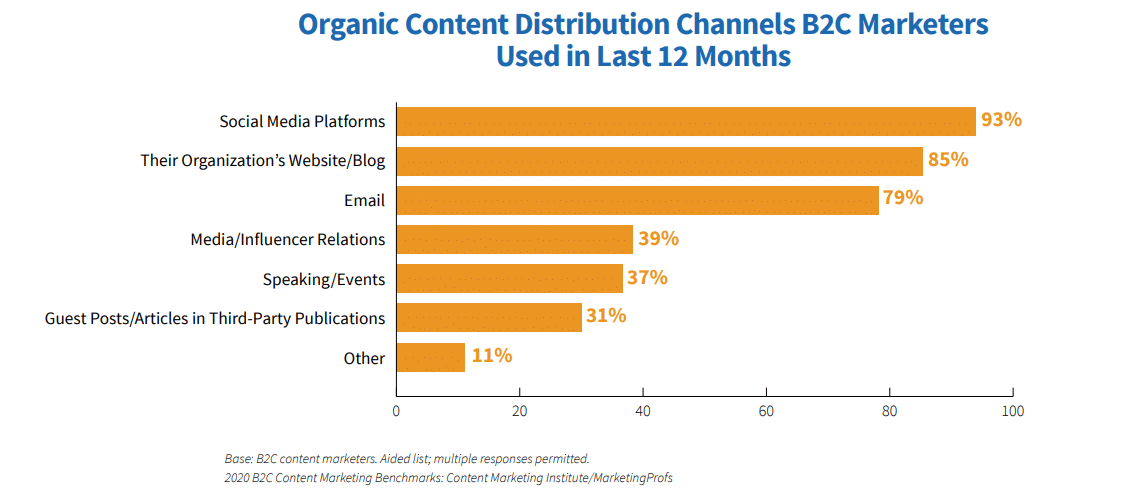
Only social media and company websites are used more often.
The same study also found that email is the most reliable channel for nurturing and converting leads to sales throughout the funnel.

It’s the leading channel to secure leads, nurture them, and a close second for converting them. Email is an integral part of the entire sales process, not just the early stages of content marketing.
Email Is a Top 3 Channel for the Social Sharing of Business Content
Email is also the second most popular channel for sharing business-related content with coworkers. A whopping 70% of professionals use email to share content related to their company or industry.
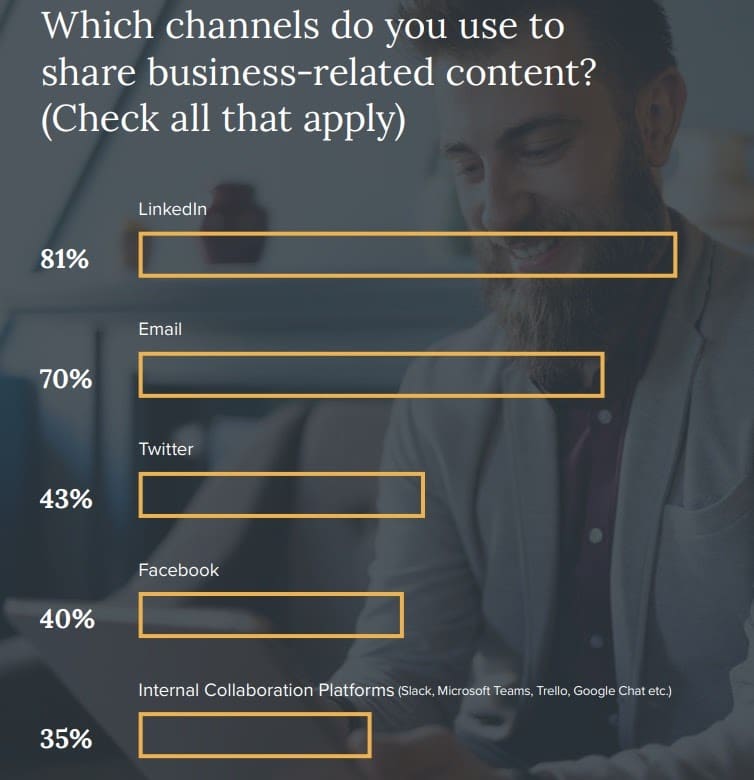
That means you can reach not just one potential lead with a marketing email. Your subscribers might also forward it directly to further members of their own network and increase your email reach.
Total Potential Email Reach and Demographics
In 2024, 4.48 billion people around the world use email. Experts expect that number to grow as high as 4.85 billion by 2027. No platform even comes close to the potential reach of email.
The latest Facebook statistics give them over 3 billion monthly active users. Even if you added them up with Instagram’s 1 billion+ users, you don’t even come close to the same number of users.
Not to mention, email has a 90.3% penetration rate among US internet users. Comparatively, only 69% of US adults are on Facebook.
What Age Group Uses Email the Most?
Millennials may be the age group that uses email the most. Data tells us that, in a 2018 study by Adobe, those who were born between 1981 and 1996 spent a whopping 6.4 hours a day on email. 41% even check their work email in bed, before or after work.
In comparison, office workers over that age only spend 5 hours per day on email.
Email is not just a marketing channel for older generations. Large parts of the business world are still managed 100% through (or partly through) emails, and the usage patterns reflect this.

The pattern here isn’t as clear-cut as the actual time spent checking their inbox and sending email statistics.
But what we can say for sure is that email is in no danger of becoming a dead channel.
Many marketers portray email as an outdated medium on the way out, but that’s not the case. It’s alive and well!
Environment Share: What Device Do People Use to Open Their Emails?
But where do consumers tend to open their emails? Nearly 42% of all email opens happen on mobile apps.
The remaining 58% is split with 18.2% for desktop apps, and 39.8% of email opens in web apps (like Gmail or Outlook.com).
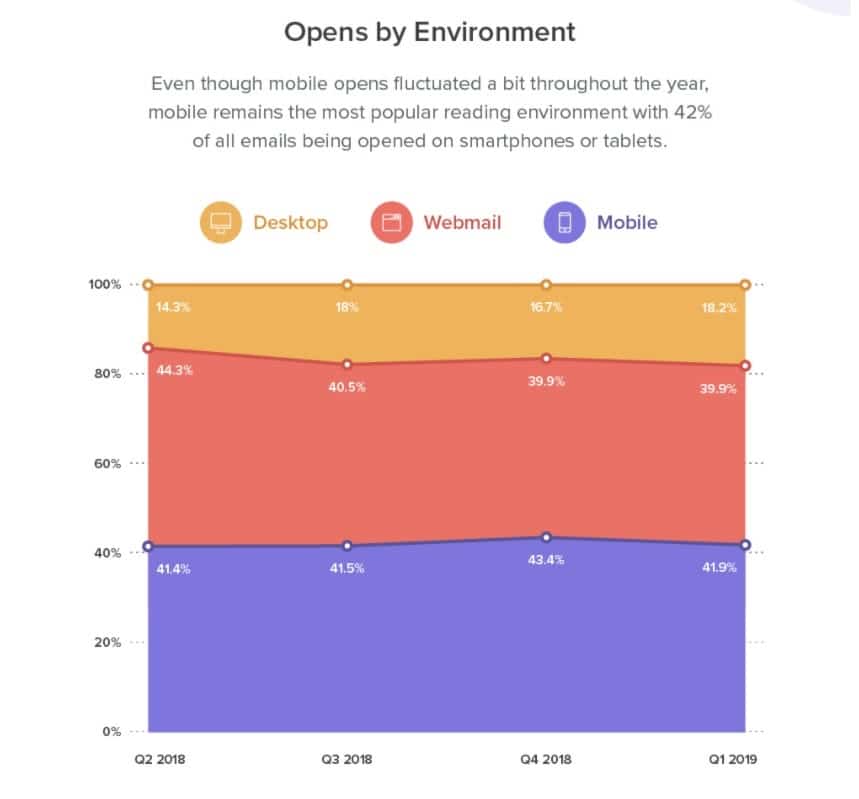
That means at least four in ten of your subscribers will probably read your email on mobile devices. So you have to keep this in mind when designing your newsletters and writing your subject lines.
Email Segmentation Statistics: Should You Segment Your Audience?
Segmented emails appear to perform significantly better than just mass-emailing an entire audience.

While opens, unique opens, bounces, and unsubscribes see some improvement, that’s not the real story here. The click-through rate of segmented campaigns is 100.95% higher (on average) than non-segmented ones.
If every subscriber is twice as likely to take action on your emails, that probably means a significant impact on your bottom line as well.
Average Email Open Rates: What Percentage of Emails Are Read?
Depending on the source, the average email open rate ranges from 18% (Campaign Monitor) to 22.15% (GetResponse). Averaged out, you get an open rate of 20.56% across four major platforms.
| Source | Average Open Rate (2019-2020) |
| Campaign Monitor | 18% |
| HubSpot | 20.94% |
| MailChimp | 21.33% |
| GetResponse | 22.15% |
Note: These numbers don’t automatically mean that one email marketing software provider is better than the other. Instead, they likely represent a discrepancy in how often and how thoroughly their users, on average, purge inactive subscribers from their lists.
Compared to organic social reach, open rates remain quite stable. Every time you send an automated marketing email, more than one in five subscribers is likely to open it, at the very least.
Open Rates by Industry
What about industry differences? Does the average amount of email subscribers who open their emails vary from category to category?
Below we’ve highlighted the differences between a few key industries.
| Industry | MailChimp | HubSpot | Campaign Monitor | GetResponse |
| Agencies | 21.39% | N/a | 18.50% | 16.10% |
| Beauty | 16.65% | N/a | N/a | 25.09% |
| Business services | 21.56% | 20% | 18.3% | N/a |
| Media & Entertainment | 22.15% | 21% | 20.80% | 28.72% |
| Retail | 18.39% | 23% | 12.60% | 22.38% |
| Real Estate | 19.17% | 26% | 19.70% | 25.48% |
- The highest average open rate registered in any industry is 28.72% in media and entertainment via GetResponse.
- The lowest registered average open rate is 12.6% in retail, via Campaign Monitor.
Media & entertainment consistently has an above-average open rate across all platforms. It may indicate that consumers are more likely to open and read emails that interest them. Emails that have some level of entertainment value could be crucial to campaign performance.
Note that the industry differences in open rates aren’t entirely consistent between providers.
Cold Outreach vs Automated Emails
It may sound counterintuitive, but when done in a compelling manner, cold outreach emails have a higher open rate than opt-in marketing emails. In fact, according to outreach.io, the open rate benchmark is 27%, almost 10% higher than the lowest average of automated email providers.
Targeted emails to central players in different companies can be a powerful marketing tool. But you have to abide by local rules and regulations on unsolicited emails (or recipients will mark your emails as spam).
Average Email Click-Through Rates: How Much Traffic Does Email Drive?
The average click-through rate of emails ranges from 2.6% (Campaign Monitor) to 3.43% (GetResponse).
| Source | Average Click-Through Rate (2019–2020) |
| Campaign Monitor | 2.6% |
| HubSpot | 7.8% (of opened emails) |
| MailChimp | 2.62% |
| GetResponse | 3.43% |
Note: HubSpot calculates the click rate based on opened emails, while other providers do so based on successfully delivered emails. Extrapolation based on its open rates means the click rate (when calculated the same way as other sources) would be around 1.6-7%.
Click-Through Rates By Industry
Let’s examine click-through rates by industry to get a more granular understanding of the lay of the land.
| Industry | MailChimp | HubSpot | Campaign Monitor | GetResponse |
| Agencies | 2.66% | N/a | 2.30% | 1.87% |
| Beauty | 1.92% | N/a | N/a | 4.19% |
| Business services | 2.72% | 8.01%* | 2.80% | N/a |
| Media & Entertainment | 4.62% | 7.71%* | 3.60% | 4.48% |
| Retail | 2.25% | 8.53%* | 1.10% | 3.39% |
| Real Estate | 1.77% | 7.17%* | 3.50% | 3.07% |
*Again, Hubspot’s click-through rates are calculated from opened emails, not all sent emails.
- Media has the highest average click-through rate, with 4.62% from MailChimp, and 4.48% from GetResponse.
- The lowest average CTR was in retail with 1.1% from Campaign Monitor.
Just like with the open rates, media does very well in click-through rates as well. That confirms the importance of providing entertainment value to your audience.
Average Email Bounce Rates: How Many Emails Make It Through?
The average email bounce rates show the percentage of emails that don’t arrive safely in the target’s email inbox.
Emails stop short of their destination because of expired email addresses, spam filters, opt-in typos, and other reasons.
The average bounce rate recorded by providers ranges from 0.58% (MailChimp) to 0.7% (Campaign Monitor).
| Source | Average Bounce Rate (2019–2020) |
| Campaign Monitor | 0.7% |
| HubSpot | 0.63% |
| MailChimp | 0.58% |
| GetResponse | N/A |
It makes sense that Campaign Monitor’s numbers are higher again, as its users appear to have pruned their lists to a lesser extent than users of other services.
Email authentication is crucial to avoid ending up in spam boxes, which drastically reduces your email’s chance of getting opened and read.
By Industry
When we look at the numbers by industry, we see similar trends as from the other industry reports.
| Industry | MailChimp | HubSpot | Campaign Monitor |
| Agencies | 0.93% | N/a | 1.10% |
| Beauty | 0.33% | N/a | N/a |
| Business services | 0.55% | 0.70% | 0.80% |
| Media & Entertainment | 0.27% | 0.30% | 0.40% |
| Retail | 0.32% | 0.40% | 0.40% |
| Real Estate | 0.56% | 0.70% | 1.40% |
Note: GetResponse doesn’t provide bounce rate data.
- On average, media and entertainment saw the lowest bounce rates with 0.27%, 0.3%, and 0.4%, respectively.
- Agencies, real estate firms, and business services are the industries with the highest bounce rates.
Average Email Unsubscribe Rates: How Many Subscribers Will You Lose per Email?
The unsubscribe rate is the average number of subscribers who will unsubscribe from your list per email you send.
The average unsubscribe rate from providers ranges from 0.1% (Campaign Monitor) to 0.48% (HubSpot).
| Source | Average Unsubscribe Rate (2019–2020) |
| Campaign Monitor | 0.1% |
| HubSpot | 0.48% |
| MailChimp | 0.26% |
| GetResponse | 0.2% |
By Industry
When we compare industry numbers, unsubscription rates again show some of the same trends as the other data.
| Industry | MailChimp | HubSpot | Campaign Monitor | GetResponse |
| Agencies | 0.35% | N/a | 0.20% | 0.16% |
| Beauty | 0.30% | N/a | N/a | 0.25% |
| Business services | 0.20% | 0.50% | 0.20% | N/a |
| Media & Entertainment | 0.12% | 0.30% | 0.00% | 0.20% |
| Retail | 0.25% | 0.50% | 0.00% | 0.19% |
| Real Estate | 0.27% | 0.60% | 0.20% | 0.20% |
- Media and entertainment have the lowest overall unsubscribe rate, with 0.12%, 0.3%, 0.00%, and 0.19%, respectively.
- Real estate and agencies have some of the highest averages across the board.
Average Email Conversion Rate: How Many Sales Will You Generate?
The conversion rate shows what percentage of marketing emails lead to sales, on average.
In 2021, the average conversion rate of emails was 1.22%, according to Barilliance. That’s just over one sale in 100 emails.
Most email marketing providers don’t share official data on conversion rates, as many users do not use the platform to track conversions directly.
When just over one in a hundred emails lead to a sale, that may not sound great.
But hang on a second.
Email marketing isn’t like other marketing platforms. You don’t have to pay for impressions or clicks.
You just pay a flat monthly fee based on the size of your list or features.
Also, many of the sales generated are upsells or repeat sales to previous customers. These tend to be higher value than first-interaction sales, which shows in the email marketing ROI numbers.
Let’s take a closer look.
Average Email Marketing ROI: Is It Worth It?
Return on investment (ROI) measures how much revenue every dollar invested in a marketing campaign generates.
In 2019, the average ROI was $42 for every dollar spent on email marketing, according to both DMA and Litmus.
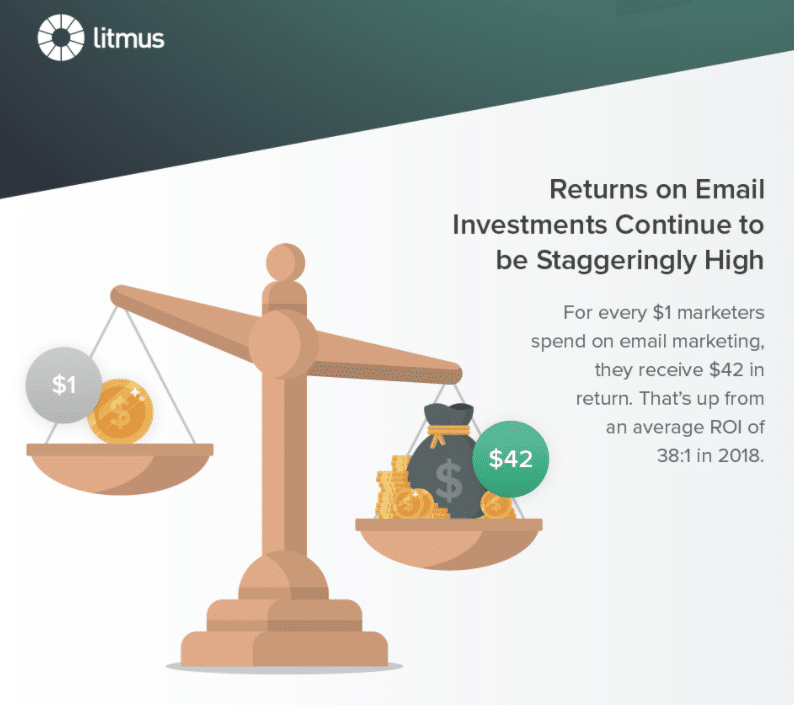
Interestingly, these studies are from different companies based in separate countries.
That’s drastically higher than the ROI on other digital marketing channels, like PPC, where Google boasts of a $1.5 return in official case studies.
Most Popular Email Marketing Automation
The best automations for orders are welcome emails, cart recovery emails, and customer reactivation automations.
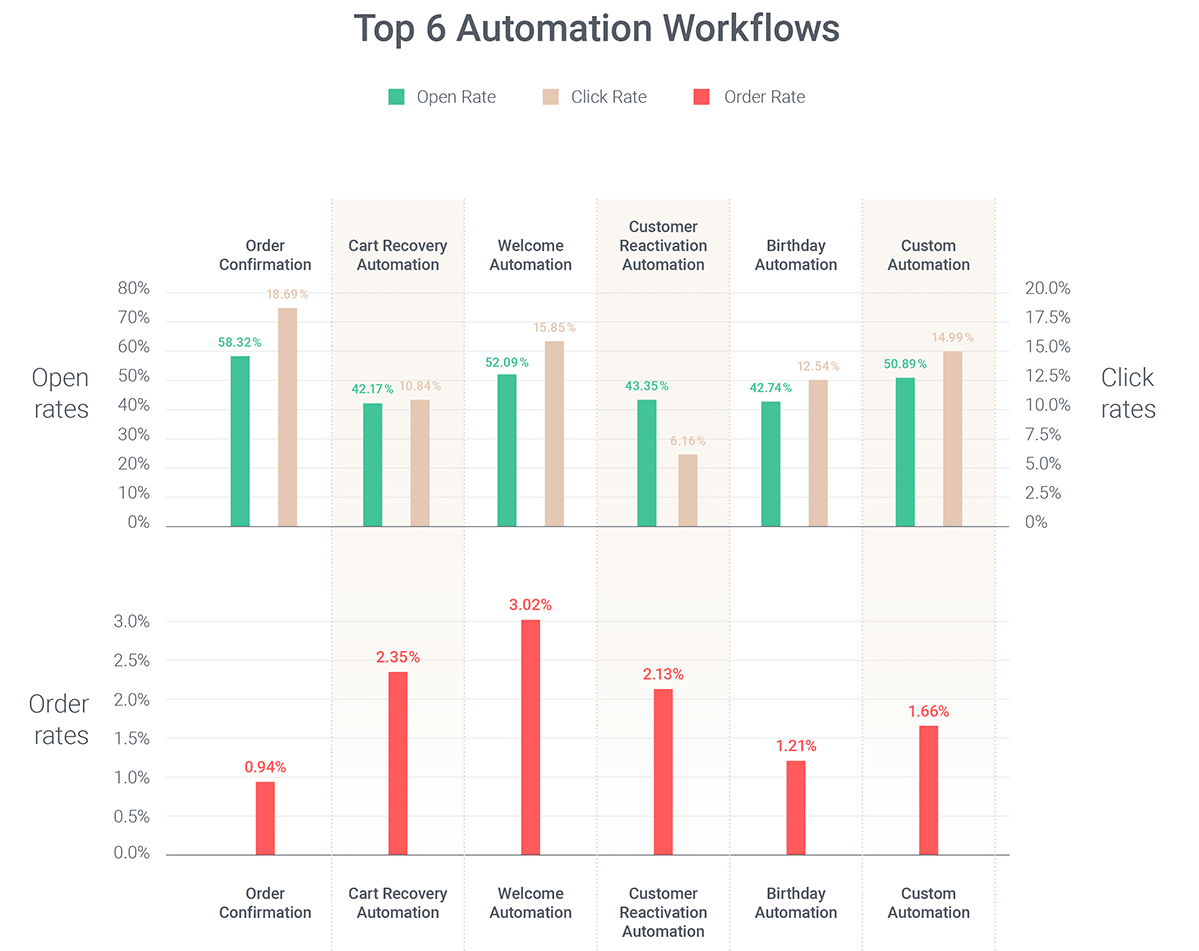
Automated welcome emails drive not only the second-highest open and click rates, but they also contribute the highest percentage of sales, with an order rate of 3.02%.
In the second place, in terms of orders, are cart recovery emails (or abandoned cart emails), with an order rate of 2.35%.
Customer reactivation emails come in third, with an average order rate of 2.13%.
All of these triggered emails are simple to set up with most email marketing providers and could net you a total of 7% extra sales or more.
That’s why any savvy digital marketer uses automations as part of their email marketing campaigns.
Let’s take a closer look at cart recovery emails in particular.
Emails Can Help You Regain Up to 8% of Abandoned Carts (And Gain 4%+ More Total Sales)
One of the biggest problems facing ecommerce stores is the high amount of abandoned carts.
By aggregating different studies, we can see that almost 70% of consumers abandon their carts without buying anything.
So what should you do?
Keep sending emails (maybe try to improve them) because if you stop, you’ll be missing out.
According to Barilliance, 8.24% of cart recovery emails lead to conversions. That’s a lot higher than the average email conversion rate of just over 1%.
That could help you land an increase in overall sales of up to 5% or more.
According to SaleCycle, the average sales uplift of implementing cart abandonment emails is 4.43%
In some industries, it’s over 6%.
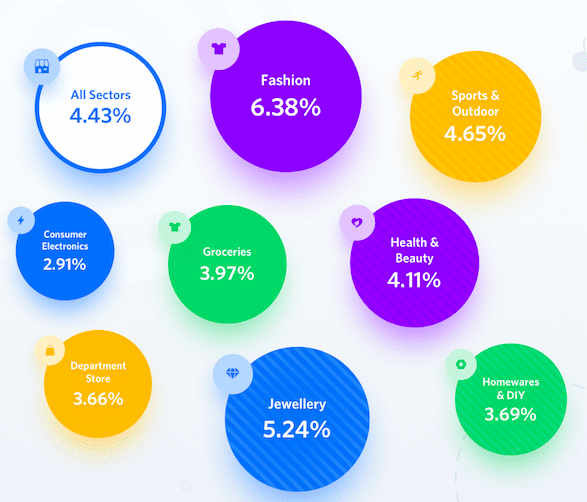
When to Send and How to Write Emails for Best Results
What better way to round off this post than by exploring the optimal email? Let’s start by looking at when exactly you should be sending emails.
What Is the Best Day to Send Marketing Emails?
Unfortunately, the best day of the week to send marketing emails depends on your industry and audience.
Data shows no conclusive universal “best day” to send emails.
The data from both GetResponse and Campaign Monitor show little variance in the average performance of campaigns based on the day of the week.
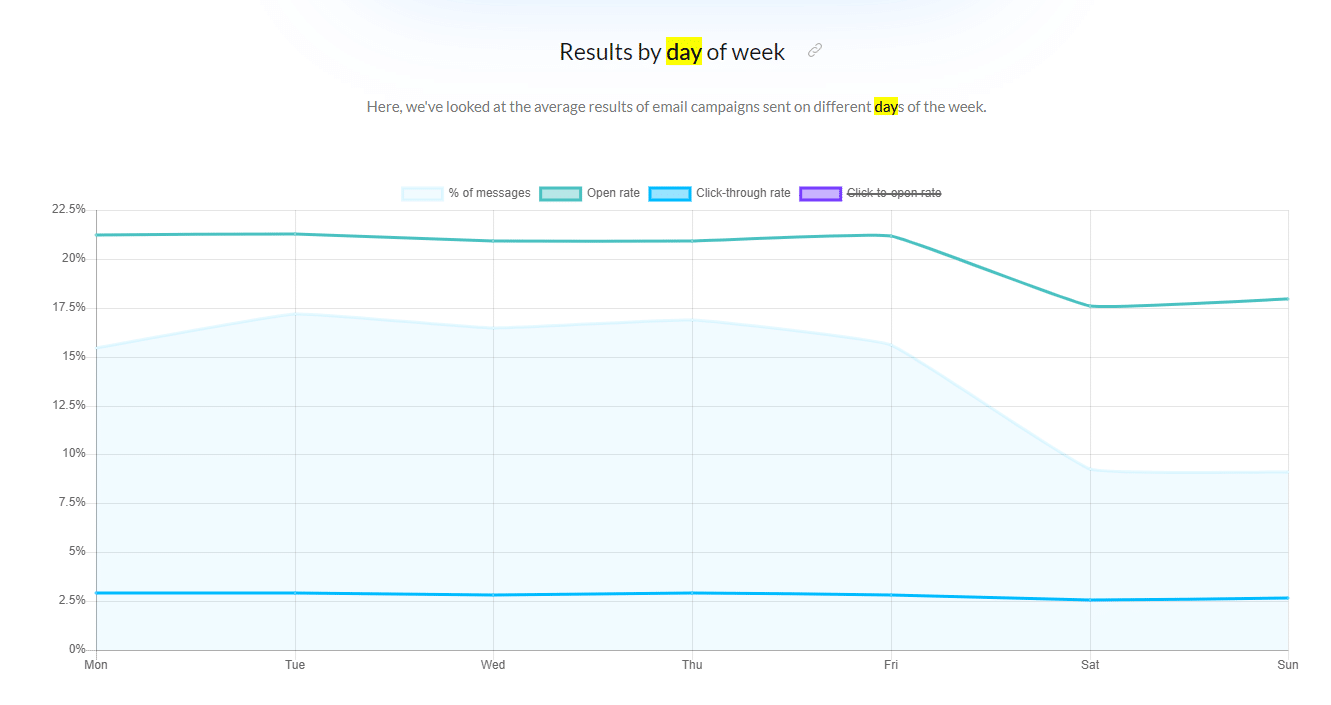
The overall volume is much lower on the weekend, and the open rates take a slight hit, but the CTR stays the same.
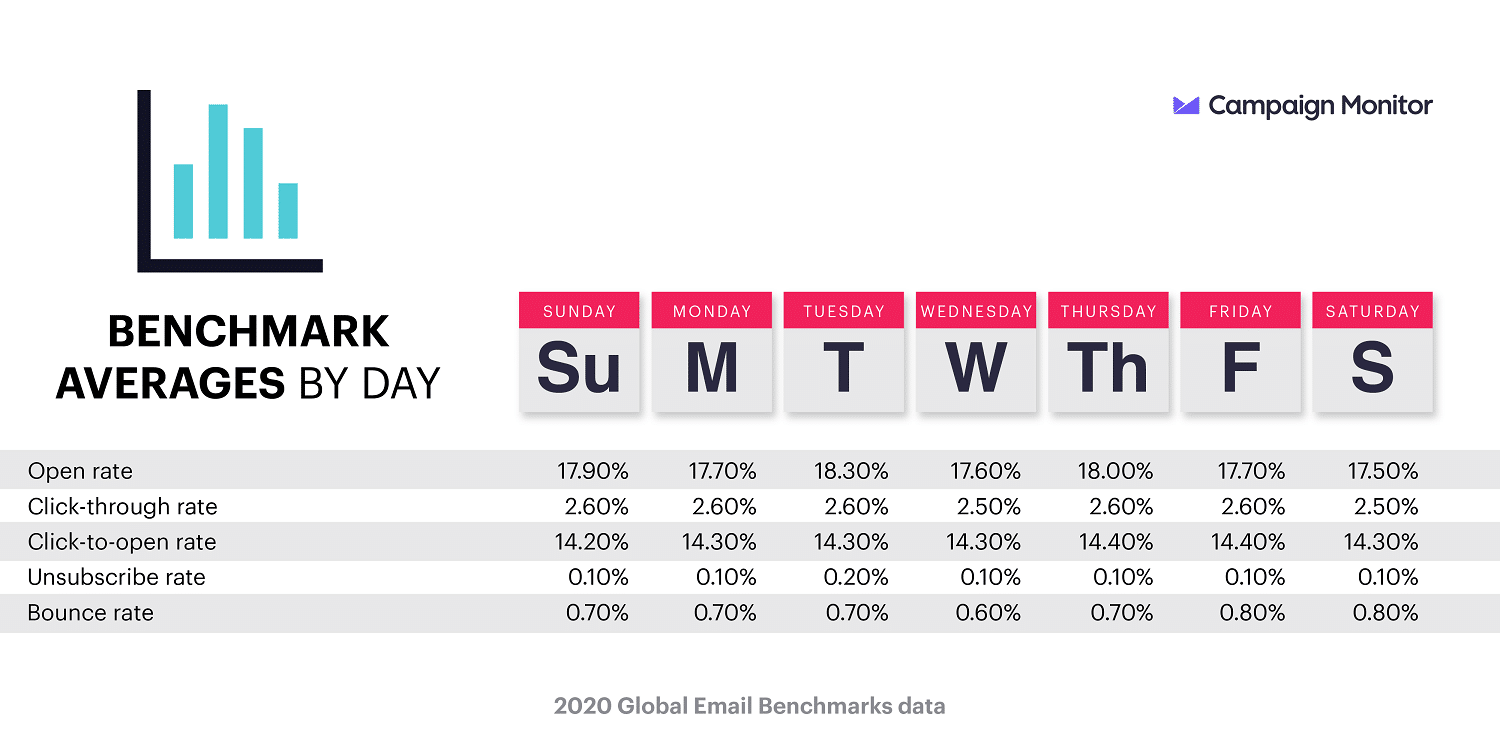
The open rate is slightly higher on Tuesdays than other days, but the CTR barely changes from day to day. Any traffic or sales numbers from these email campaigns are likely comparable as well.
So does that mean you should send your emails on any random day you want? Not necessarily.
Previous research by MailChimp suggests that optimal send times depend on industry and demographic factors.

So while the averages do not change, it’s still worth it to run A/B tests to find the best day of the week for your subscribers.
There’s no universal right answer, but you might find that a specific day delivers significantly better results with your audience.
What Is the Best Hour to Send Marketing Emails?
Emails delivered in the early morning appear to give the best results for each email sent. At least, that’s the clear conclusion according to research by Omnisend.
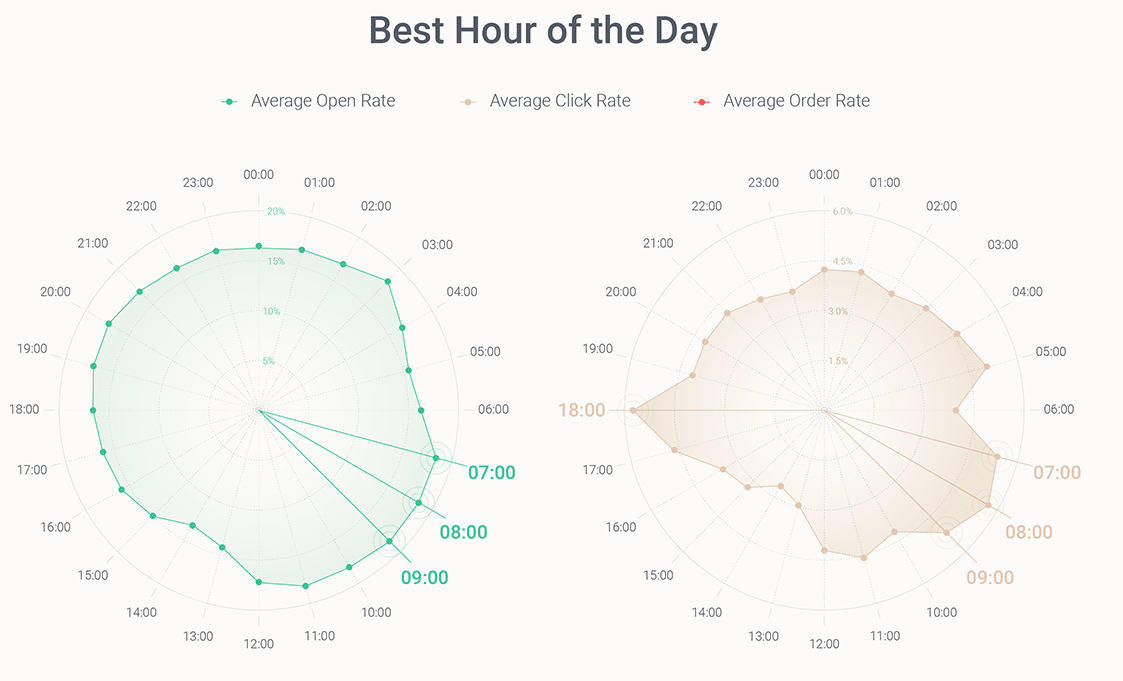
In terms of open rates, the morning hours between 7 and 9 AM appear to have a noticeable advantage.
6 PM appears to be the best time to send emails to drive sales, with the highest average order rate.
Data from GetResponse shows that the bulk of emails are sent during this time, but don’t necessarily get the best results.

Instead, the highest open rates appear to take place closer to 1 PM, around lunchtime, but face a steep drop-off in the afternoon hours.
CTR also peaks at 6 PM, as the average order rate from the Omnisend data. It might be worth experimenting with sending coupons or offer-based emails at 6 PM rather than in the mornings.
Ideal Subject Line Length
What is the ideal number of characters you should use in your email subject lines?
Brief subject lines seem to underperform both in terms of click-through rates and overall engagement.
The vast majority of emails are sent with subjects of 100 characters or less. But longer subject lines (110–140 characters) have higher click-through and open rates.
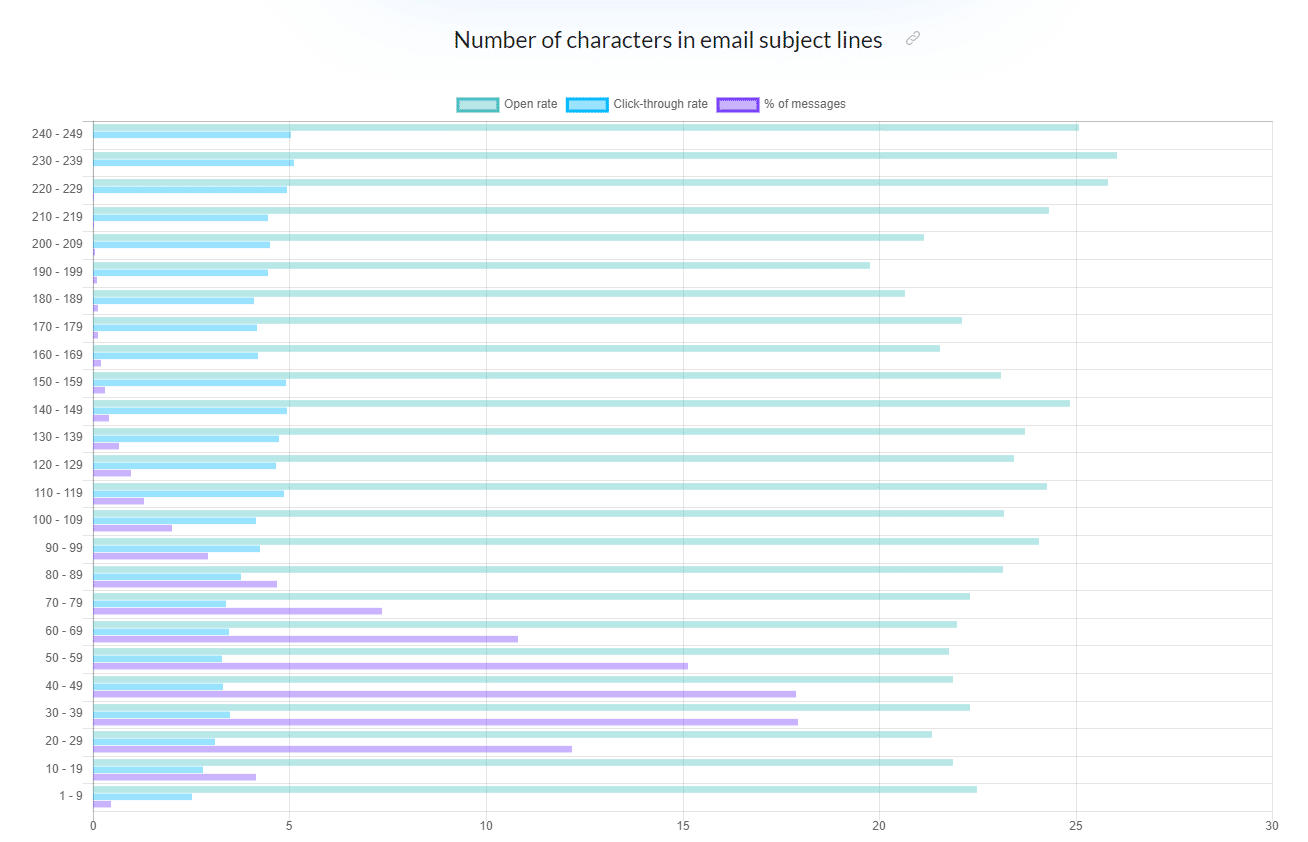
Research from Marketo shows a similar trend with click-through rates, where longer is better, up until a point.

The drastic difference in CTRs probably indicates a difference in the quality of copywriting, and not just adding or subtracting a word in an identically good subject line.
The results probably also differ based on the industry and the target audience. Whether the subscriber views the email on a mobile device or desktop could also make a difference.
But don’t be afraid of going longer than a few words.
Should You Use Emoji in Subject Lines?
What about emojis? Should you use them in subject lines? According to the data, the answer appears to be yes.
While under 4% of emails sent include emojis, the average open rate is exactly 3% higher than emails without them.

Whenever it makes sense, you could try to experiment with subject lines to boost your open rates.
Do Personalized Subject Lines Perform Better?
Does a personalized subject line really perform better?
The answer seems to be yes, but only by a little bit. With under 12% of total messages and an open rate that’s only 0.54% better, it’s far from conclusive.

It could also be that email marketers who send personalized emails also tend to write slightly better copy.
What Words Make Your Subject Line More Clickable?
Finally, let’s take a look at the words and symbols that make your subject line more clickable.
Only a few of the words and symbols appear to push the emails above GetResponse’s 22.15% average open rate.
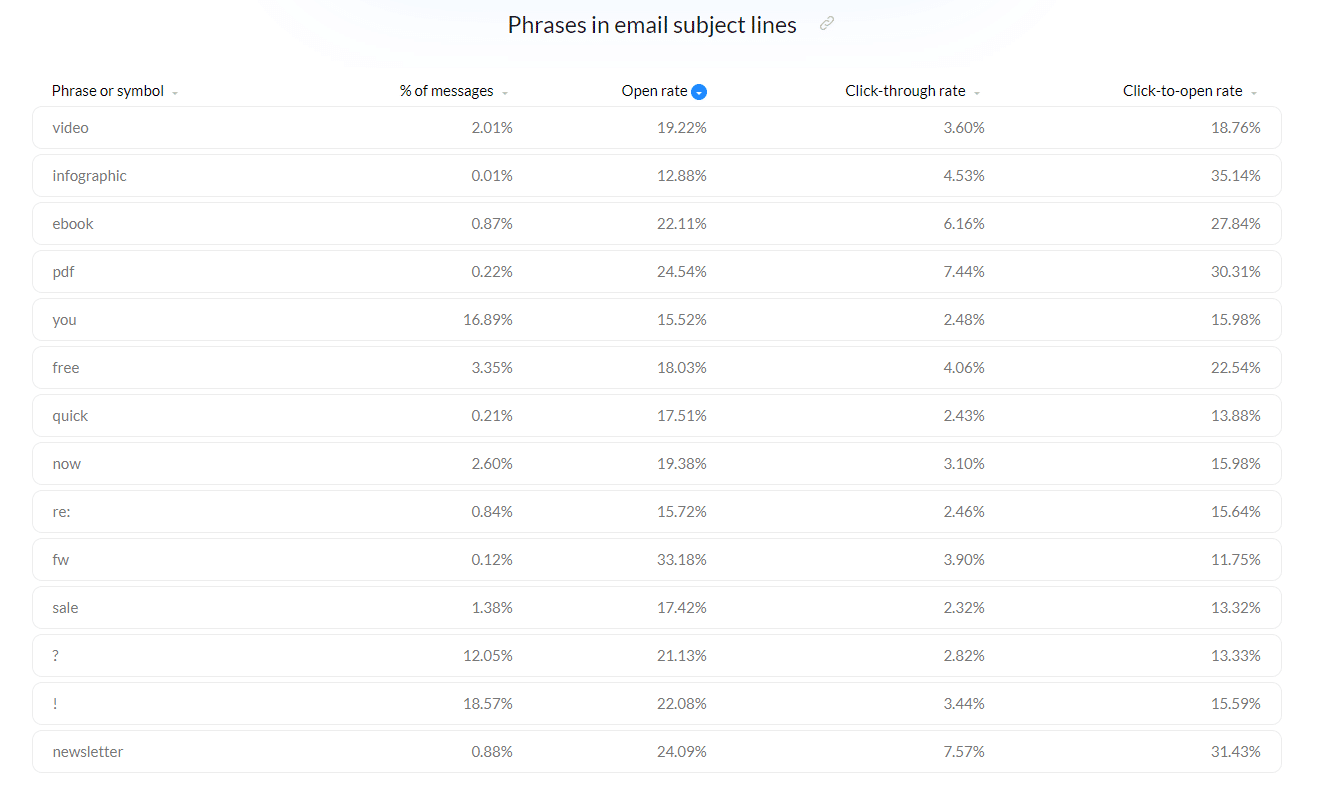
- Newsletter – The 24.09% open rate is noteworthy because the word doesn’t imply someone signed up to immediately download something via email.
- FW – 33.18% open rate, but very small sample size and slightly dishonest (pretends to not be an automated email).
- PDF – 24.54% open rate could be caused by email-locked downloads of reports or white papers.
- You – A 15.52% warns against using this word in your email subject lines.
Use Animated GIFs in Emails to Engage Your Audience
Emails are no longer limited to long, droning paragraphs of static text.
Marketers aren’t just using emojis in the subject line to try to catch the attention of their subscribers.
They’re also using animated GIFs to make their emails more engaging. 56.5% of marketers use GIFs in at least some of their marketing emails.
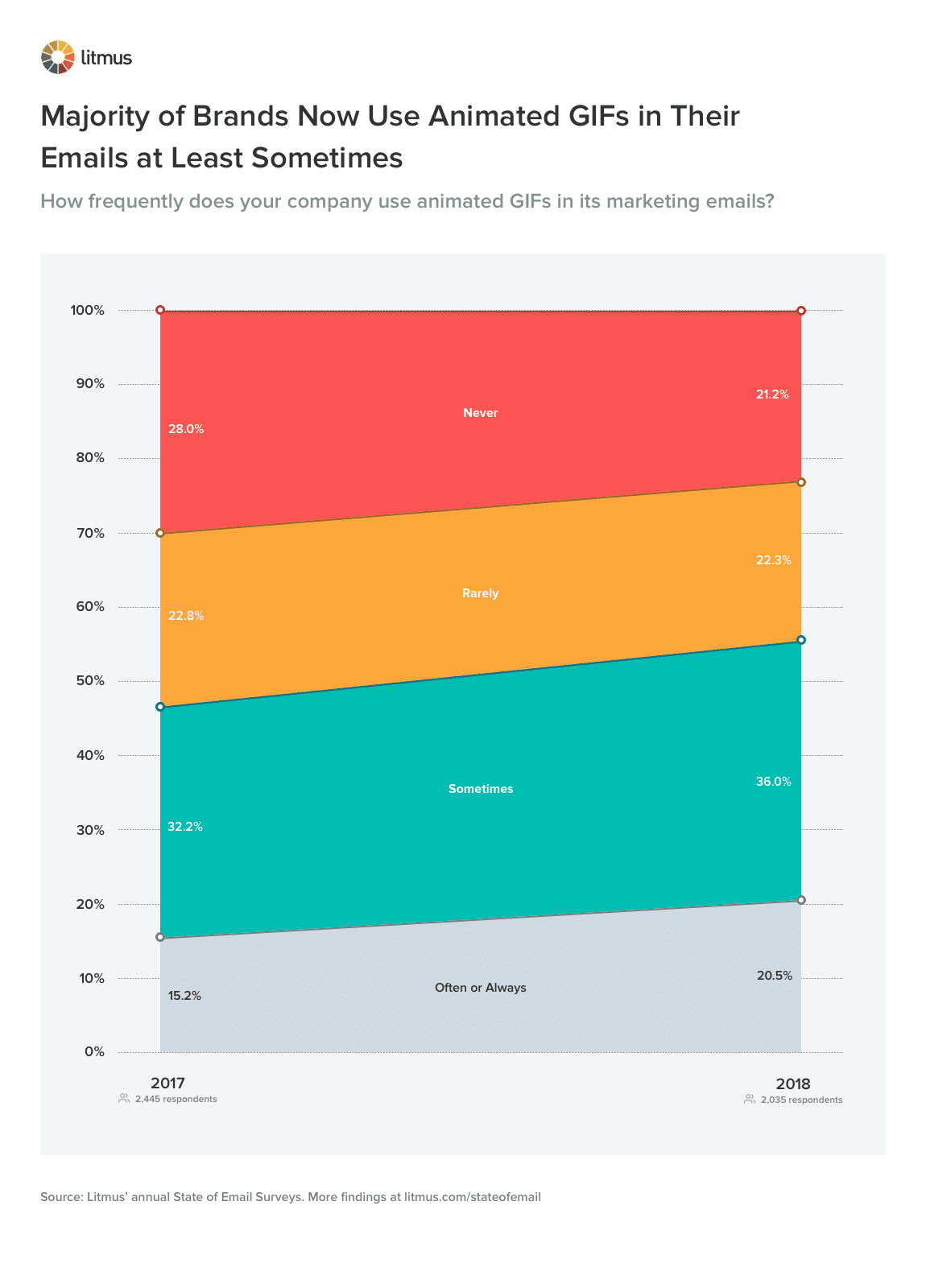
You can use an animated GIF to showcase a new feature in action, spice up the visuals for a new product, and much more. And while we’re at it, don’t forget to choose the perfect font for your emails.
Most Important Metrics to Measure When Trying to Improve Emails
But what metrics should you focus on to see if your emails are performing? Most marketers think CTR, open rates, and post-email conversions are the three most important ones.

By focusing on the right data, you can easily see if the changes you make to your emails have a positive impact or not.
How Long Should You Spend on a Single Email?
The majority of brands spend multiple weeks on a single marketing email.
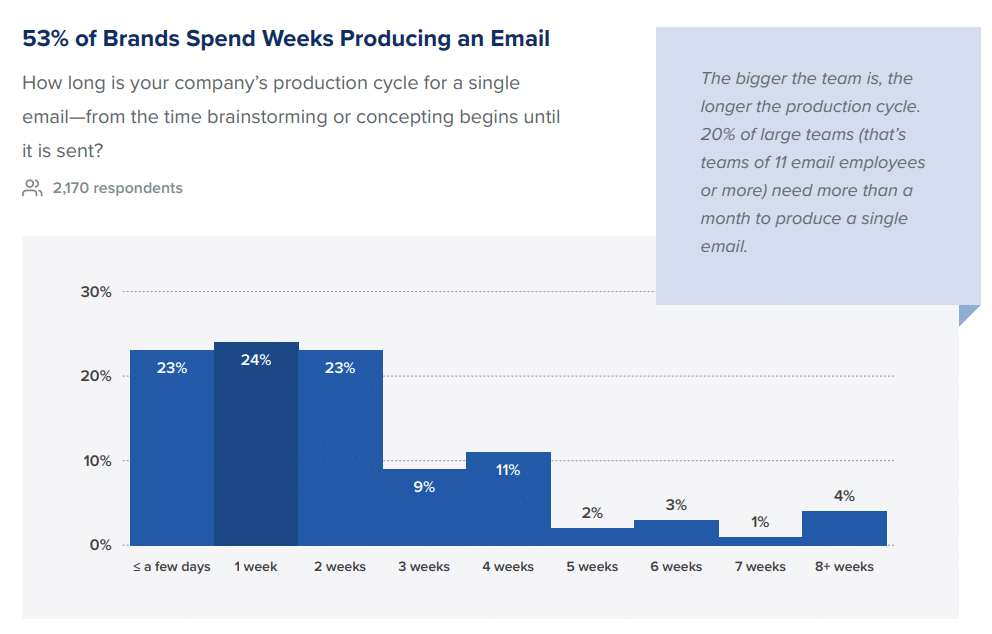
That’s because the email follows a rigorous, multi-stage process from brainstorming until it’s reviewed and accepted.
If you’re on a smaller team, you obviously don’t need to spend as much time per email.
Of course, no team is working on just a single email for months. The majority of email marketing teams handle at least five emails at any given time.

What Area Should You Focus the Most On When Creating Emails?
When creating your email, what should you invest the most time and resources into?
On average, companies spend more time on design, coding, and review.
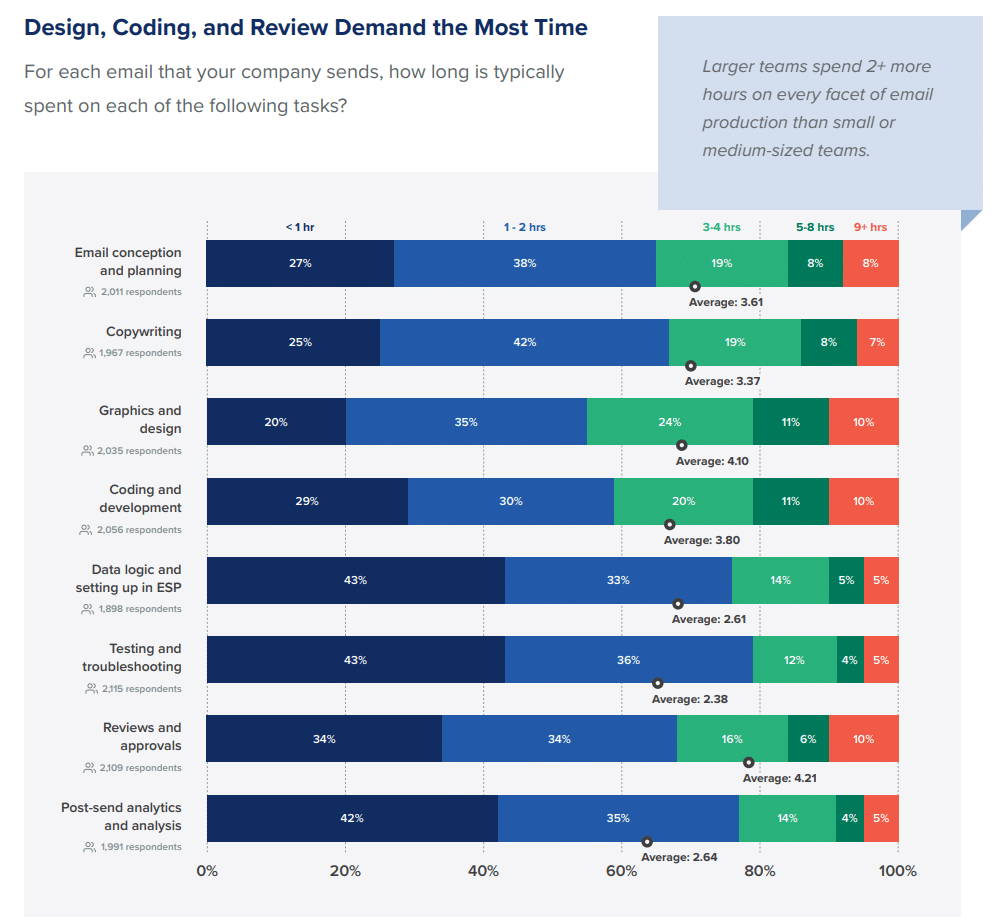
That makes sense, as design and coding impact the actual email experience more than any other stage.
And in the review, senior editors have to optimize the copy and ensure the email follows brand guidelines to a T.
Summary
Email marketing is not dead, it’s far from it. In 2022, it’s still one of the best channels a business of any size can invest in.
With an average return of over 40 times what you invest, you can’t afford to ignore it.
While average open rates and click-through rates are lower than before, it’s still an effective way to nurture relationships with your customers, rewin potentially lost business, and reactive inactive users.
Any business that’s dismissing email is missing out, and missing out big.


